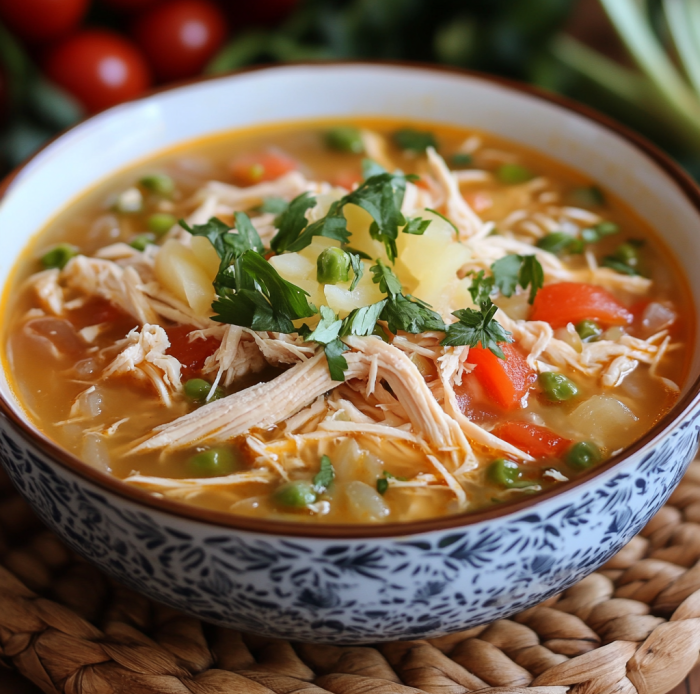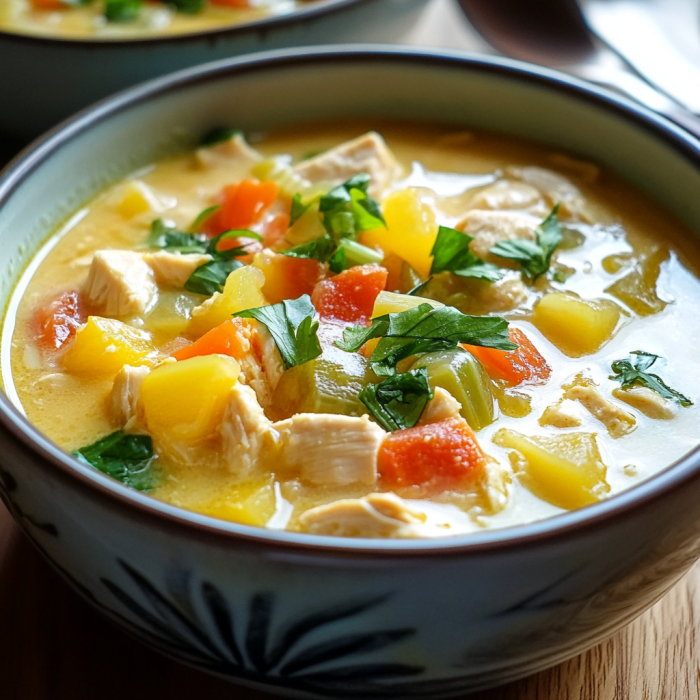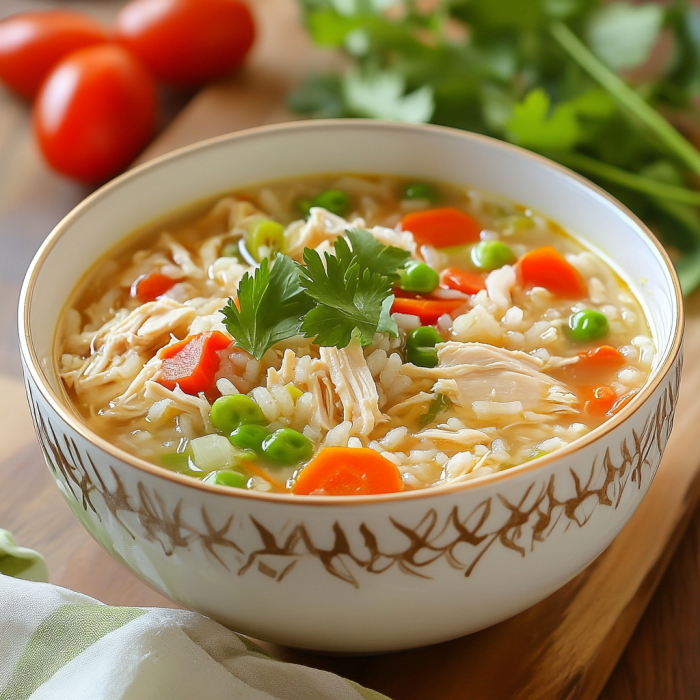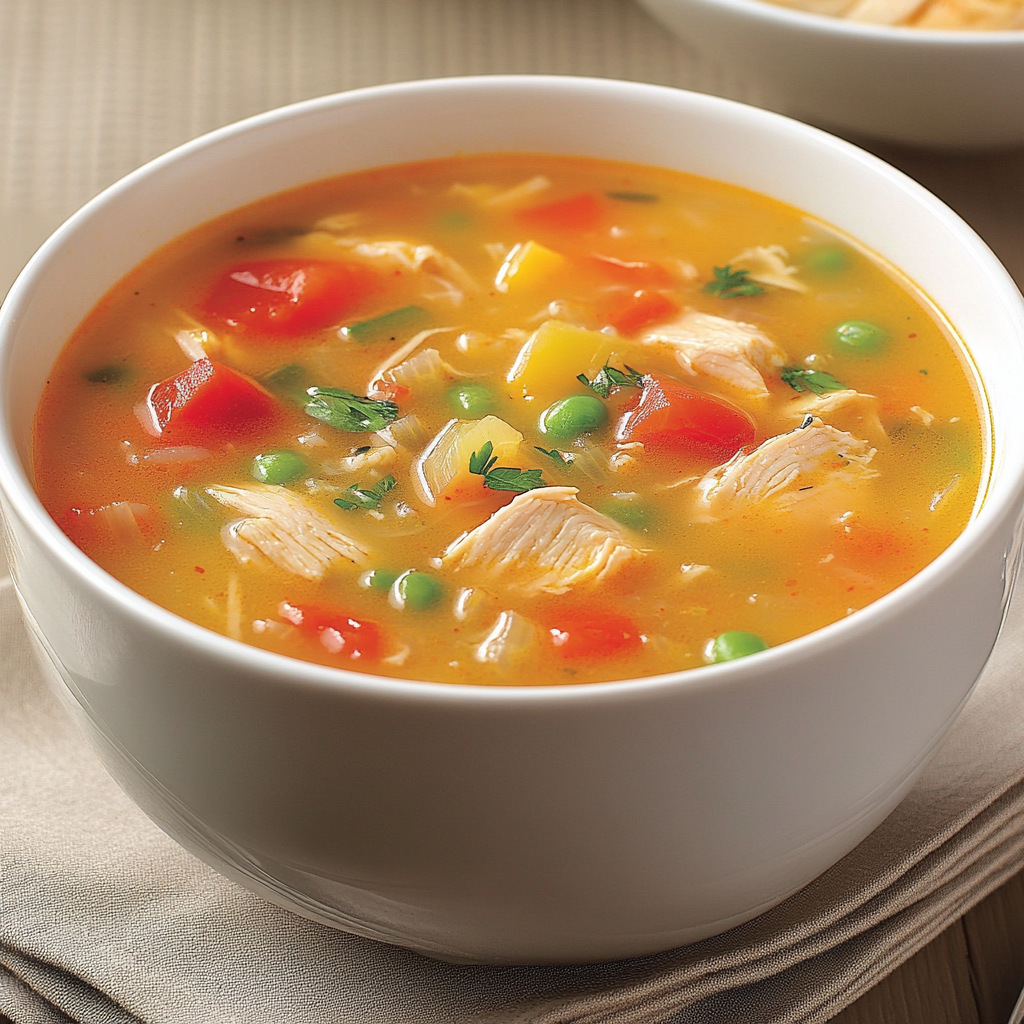
Imagine walking into a cozy Hawaiian home. The air is filled with the warm smell of chicken long rice. This soup is more than just a meal; it’s a story of comfort, culture, and community.
For many, it brings back memories of family gatherings and shared meals. It’s a dish that connects us to our heritage, blending history and heart. Now, you can bring that warmth into your own kitchen.
Hawaiian soup traditions are filled with stories, and chicken long rice is a favorite. Its silky broth, tender chicken, and slippery noodles create a perfect mix of flavors. This guide will show you how to make it using traditional methods, so you can enjoy a taste of Hawaii’s culinary soul.
Whether you’re new to Hawaiian cooking or already a fan, this article will guide you through every step. You’ll learn how to make the broth just right, handle the noodles to avoid clumping, and even try a Filipino twist. Along the way, you’ll see why this dish is so beloved—it’s nutritious, comforting, and deeply connected to Hawaii’s vibrant history.
Key Takeaways
- Chicken long rice blends Hawaiian and Chinese culinary traditions into one comforting bowl.
- Making this hawaiian soup at home requires simple ingredients but precise techniques for perfect texture and flavor.
- Learn to adjust seasonings to balance savory, salty, and subtle sweetness in every spoonful.
- Discover both traditional Hawaiian and Filipino-style preparation methods side by side.
- Master tips to store and reheat leftovers without losing the dish’s signature freshness.
What Is Chicken Long Rice? History and Cultural Significance
Chicken long rice is more than a meal; it’s a tale of migration and adaptation. This hawaiian soup comes from 19th-century Chinese laborers who brought bean thread noodles to Hawaii. Over time, these long rice noodles mixed with local ingredients like chicken, taro, and vegetables, becoming the dish we know today.
Origins of This Hawaiian Favorite
Chinese immigrants brought stir-fry techniques to Hawaii. But, the climate and resources led to a soup version of chicken long rice noodles and broth. This change made it a beloved comfort food.
- Chinese immigrants: Brought noodles and cooking methods
- Hawaiian adaptation: Added local proteins and vegetables
The Chinese Influence on Hawaiian Cuisine
Early settlers mixed traditions with Hawaiian ingredients, creating fusion dishes. Soy sauce and ginger stayed, while chicken and sweet potatoes became key. This blend shaped the dish’s identity as a cultural bridge between two worlds.
| Chinese Contribution | Hawaiian Adaptation |
|---|---|
| Stir-fry techniques | Soup-based preparation |
| Rice vermicelli | Bean thread noodles |
| Wonton wrappers | Taro leaves and broth |
Why It’s Called “Long Rice” When It’s Actually Bean Thread Noodles
The term long rice noodles is a linguistic quirk. Chinese immigrants called the noodles “rice threads,” but locals thought it meant “long rice.” The name has stuck, even though the noodles are made from mung beans, not rice. This mix-up shows how cultures blend over time.
“The name is a reminder of the cross-cultural dialogue that shaped Hawaiian cooking,” explains the Hawaiian Culinary Heritage Society.
Knowing its history makes you appreciate each spoonful of chicken long rice more. Every ingredient tells a story of resilience and creativity.
Essential Ingredients for Authentic Chicken Long Rice
To make authentic chicken long rice, you need the right ingredients. Here’s what you need:
- Long rice noodles (bean thread noodles): These noodles are the dish’s star. They are made from mung bean starch. You can find them in Asian grocery stores or online. Soak them in warm water for 10-15 minutes to get their springy texture.
- Chicken: Use bone-in thighs for rich broth or boneless breasts for tenderness. Pat them dry before cooking to ensure even browning and flavor infusion.
- Aromatics: Freshly grated ginger, minced garlic, and thinly sliced green onions form the soup’s aromatic base. Avoid powdered substitutes for true authenticity.
- Seasonings: Hawaiian red salt (like Alaea salt) adds mineral-rich saltiness. Use toasted sesame oil for nutty depth and tamari or low-sodium soy sauce to balance umami without excess sodium.
Quality ingredients are key to success. Make your broth from simmered bones for depth. If you can’t find long rice noodles, rice vermicelli is a poor substitute. Always taste and adjust seasonings gradually to avoid overpowering flavors.

Step-by-Step Guide to Making Perfect Chicken Long Rice
Want to make chicken long rice like a pro? Follow this guide for a delicious Hawaiian soup. Pay close attention to each step for a top-notch dish.
Preparing the Chicken Broth
Start with a flavorful broth. Use a whole chicken, onions, ginger, and garlic. Simmer for 1.5 hours to get the best taste. Then, strain the broth to keep it clear.
- Place chicken, halved onions, and sliced ginger in a large pot.
- Simmer gently on low heat for 1.5 hours, skimming foam periodically.
- Strain broth through a sieve, reserving cooked chicken for shredding later.
Handling Long Rice Noodles Properly
Long rice noodles can be tricky. Soak them in warm water for 20 minutes to soften. Then, drain and cut with scissors to avoid clumps.
“Proper soaking is the secret to avoiding clumps,” says Honolulu’s culinary tradition. Soak noodles in warm water for 20 minutes, then drain and cut with scissors to prevent tangling.
Combining All Elements
Now, put everything together. Reheat the broth, add noodles and chicken. Simmer briefly to mix the flavors.
- Add noodles 3 minutes before serving to avoid overcooking.
- Layer ingredients in this order: broth, noodles, chicken, then garnishes.
Adjusting Seasonings for Authentic Flavor
Season with soy sauce, fish sauce, and salt. Taste and adjust before serving. A dash of white pepper adds warmth without being too strong.
Tip: Never overcook noodles—they should be slightly chewy. Adjust the broth’s saltiness with fish sauce for the right balance.
Filipino Chicken Long Rice Recipe Variation
The filipino chicken long rice recipe is a tangy twist on Hawaiian chicken long rice. It adds Southeast Asian flavors to the dish. This version is known for its bold, bright tastes, making it unique.
Key Differences in the Filipino Version
The Filipino version uses a lighter broth. Instead of coconut milk, it uses fish stock or bonsoy for flavor. The noodles are sautéed with ginger, garlic, and onion before adding broth. The main differences are:
- Calamansi juice adds acidity instead of sweeteners
- Siling labuyo (bird’s eye chili) adds spice
- Shredded carrots or bell peppers add crunch
Spice and Ingredient Additions
The Filipino version loves strong spices. You’ll find:
- Patis (fish sauce) for umami
- Ground annatto (atsara) for color and flavor
- Fresh kalamansi for a burst of citrus
Some cooks add tinapa (smoked fish) flakes for a smoky taste. This shows how coastal Filipino culture influences the dish.
Unique Preparation Steps
In Filipino kitchens, noodles are briefly soaked in warm water. This is different from Hawaiian’s longer soaking. The soup simmers quickly, with scallions and malunggay (moringa) leaves added at the end. This method keeps the noodles’ texture.

“It’s not just a dish—it’s a journey. Every Filipino family adds their story through spices,” says Manila-based chef Lourdes Montinola, who popularized the variation in her 2022 cookbook.
Trying the filipino chicken long rice recipe lets you see how cultures blend in food. It creates a tangy, aromatic dish that connects two island cuisines with every bite.
How to Make Chicken Long Rice in an Instant Pot
Turn your Instant Pot into a time-saving machine for chicken long rice. This method cuts down on prep and cook time, keeping the dish’s flavor intact. Here’s how to make a quick, top-notch meal:
- Sear chicken thighs in the Instant Pot on sauté mode. Add ginger, garlic, and soy sauce for base flavor.
- Add 4 cups broth, bring to a boil, then pressure cook on high for 7 minutes. Let pressure release naturally for 5 minutes before quick release.
- Add bean thread noodles directly into the pot. Let sit for 2-3 minutes to soften without overcooking.
- Season with green onions and sesame oil before serving.
| Step | Traditional Method | Instant Pot |
|---|---|---|
| Total Time | 2.5 hours | 30 minutes |
| Noodle Prep | Soak noodles separately | Rehydrate in broth during last step |
| Broth Development | 2-hour simmer | 15 minutes under pressure |
“The secret is timing the noodles right—add them only after pressure releases,” say home cooks mastering this shortcut.
- Use 1 cup broth per 2 oz noodles to prevent clumping.
- Check noodles at 2 minutes—adjust seasoning before serving.
Enjoy this chicken long rice with kimchi or steamed rice for a complete meal. The Instant Pot version keeps the dish silky while saving 90% of traditional cooking time. It’s a modern twist on Hawaiian comfort food, perfect for busy days.
Common Mistakes to Avoid When Making Hawaiian Soup
Getting hawaiian soup just right needs careful attention. Steer clear of these common mistakes to keep your soup tasty and true to its roots.
Noodle Texture Issues and Solutions
Bad long rice noodles can mess up your soup’s feel. Here’s how to avoid it:
| Problem | Why It Happens | Fix It |
|---|---|---|
| Mushy noodles | Over-soaking or boiling too long | Soak noodles only 20 minutes; add to soup last 5 minutes of cooking. |
| Clumping | No stirring during soaking | Rinse noodles gently and stir occasionally while soaking. |
Broth Flavor Balance Tips
A weak broth can let down your whole dish. Here’s what to do:
- Use homemade chicken broth for depth
- Add soy sauce gradually—over-salting is easy
- Simmer broth uncovered to concentrate flavors
Timing Considerations for Perfect Results
Timing is everything:
- Simmer chicken 20-25 minutes for tender meat
- Add long rice noodles last to prevent sogginess
- Let broth reduce uncovered for 10 minutes before serving
Serving Suggestions and Pairings for Your Chicken Long Rice
Once your chicken long rice is ready, add to the fun with the right sides and garnishes. These choices bring out the best in this Hawaiian soup. They make your meal complete and true to Hawaiian tradition.
Traditional Hawaiian Side Dishes
Try these classic sides with your bowl:
- Poi: A paste from fermented taro, it adds a tangy touch to the soup’s richness.
- Lomi Lomi Salmon: Spiced salmon with onions and chili, it’s salty and sweet.
- Hawaiian Macaroni Salad: A creamy pasta salad with veggies, it’s a creamy delight.
Garnish Options to Enhance Flavor and Presentation
Make your bowl pop with these garnishes:
- Fresh cilantro or green onions for a fresh taste
- Lime wedges for a burst of citrus
- Toasted sesame seeds or crushed peanuts for a crunchy bite
Beverage Pairings for a Complete Meal
Choose drinks that match your Hawaiian soup with:
- Kona Coffee: A local roast for a great start or finish.
- Sparkling water with fresh mint or pineapple slices.
- Cold coconut water for a refreshing tropical drink.
These drinks and sides turn your chicken long rice into a true Hawaiian feast.
Storage, Reheating, and Make-Ahead Tips
Keep your chicken long rice delicious with these tips. Follow these steps to keep the broth rich and the noodles tender for later.
- Separate components: Store broth and noodles in labeled containers. Keep noodles dry to prevent clumping.
- Freeze smartly: Freeze broth in ice cube trays for easy portions. Wrap noodles in parchment paper before freezing.
- Refrigerate safely: Consume refrigerated chicken long rice within 3 days. Freeze leftovers for up to 2 months.
Reheat with care to maintain texture:
- Warm broth on low heat until steaming, never boiling.
- Add noodles directly to hot broth and simmer for 1-2 minutes.
- Stir gently to avoid breaking the long rice noodles.

“The secret is patience—never rush the noodles.” Culinary experts advise reheating in small batches for best results.
For meal prep, prepare broth in bulk and store noodles individually. Reheat portions as needed. Add fresh scallions or lime juice to leftovers for a flavor refresh. Always cool soup within 2 hours to ensure safety.
Conclusion: Embracing the Comfort of Hawaiian Chicken Long Rice
Chicken long rice is a symbol of Hawaii’s rich food history. It mixes Chinese, Filipino, and local tastes into one delicious dish. Enjoyed as a soup or a spiced Filipino recipe, it brings cultures together with every bite.
Its ingredients—chicken, noodles, and herbs—carry the traditions of many generations. By trying both versions, you see how migration and exchange shaped Hawaiian food. You can adjust the flavors to your liking, whether cooking in an Instant Pot or on the stovetop.
This dish is perfect for any occasion, from cozy nights to big gatherings. It’s also great for leftovers, making it a convenient choice for busy days. Sharing this soup starts conversations about its origins.
Every bowl of chicken long rice tells a story of strength and connection. Now that you know how to cook it just right, make it a regular part of your meals. Serve it with kim chee or lechon-inspired spices to enjoy Hawaii’s culinary heritage at home.
FAQ
What are the main ingredients in Chicken Long Rice?
Chicken Long Rice has chicken, bean thread noodles, ginger, garlic, and green onions. It also needs a tasty chicken broth. Don’t forget soy sauce, sesame oil, and Hawaiian salt for the authentic taste.
Can I make Chicken Long Rice in an Instant Pot?
Yes, you can make Chicken Long Rice in an Instant Pot! It cooks faster and the broth gets richer. Just remember to cook the chicken and noodles at the right times to avoid mushiness.
What is the difference between Hawaiian and Filipino Chicken Long Rice?
Hawaiian Chicken Long Rice might have soy sauce and sesame oil. Filipino versions often add calamansi and patis. These differences show how the dish changes as it travels between islands.
How should I store leftovers of Chicken Long Rice?
Store leftovers in an airtight container in the fridge for up to 3 days. Freeze it for longer storage, but keep noodles separate. Reheat gently to keep noodles from getting mushy.
What side dishes pair well with Chicken Long Rice?
Try poi, lomi lomi salmon, or Hawaiian macaroni salad with Chicken Long Rice. They add great flavors and textures to your meal.
Why is it called “long rice” if it’s made with noodles?
It’s called “long rice” because of the long, thin bean thread noodles. This name comes from Chinese influence on Hawaiian cuisine, where noodle dishes were known as “long rice.”
What are common mistakes to avoid when making Chicken Long Rice?
Avoid overcooking noodles to prevent mushiness. Also, make sure the broth isn’t too bland or too salty. Paying attention to cooking times and seasoning helps achieve the best taste and texture.



